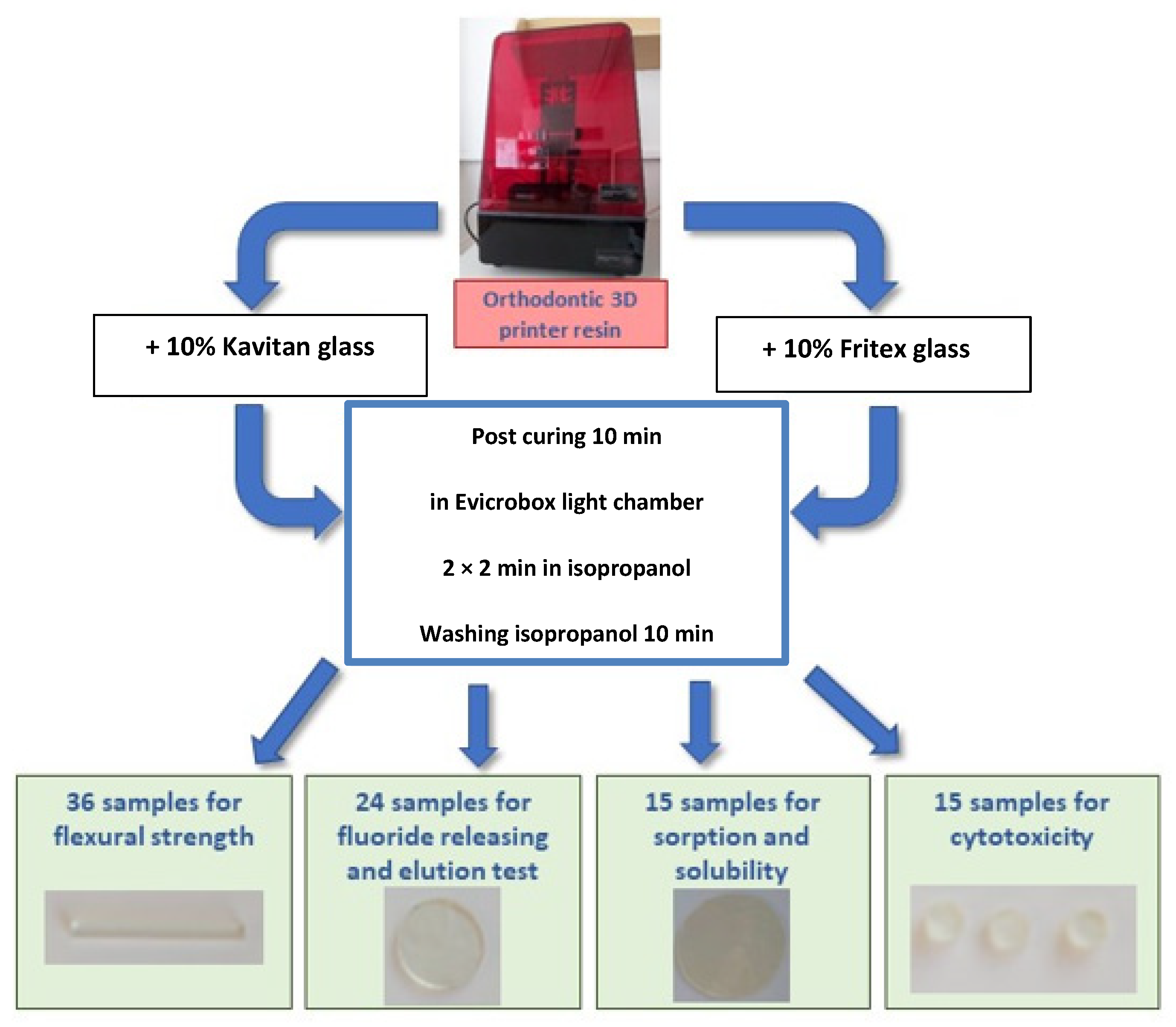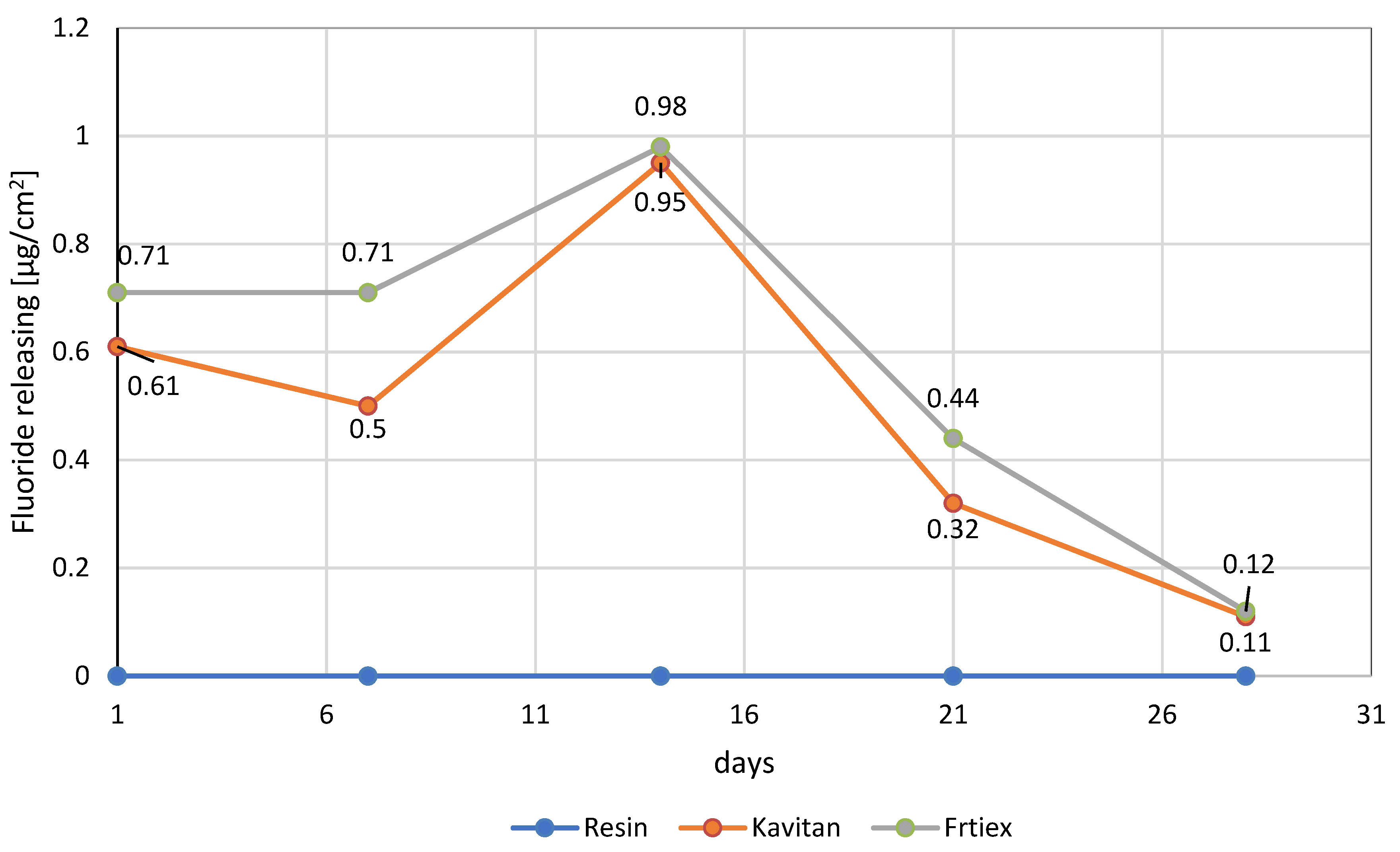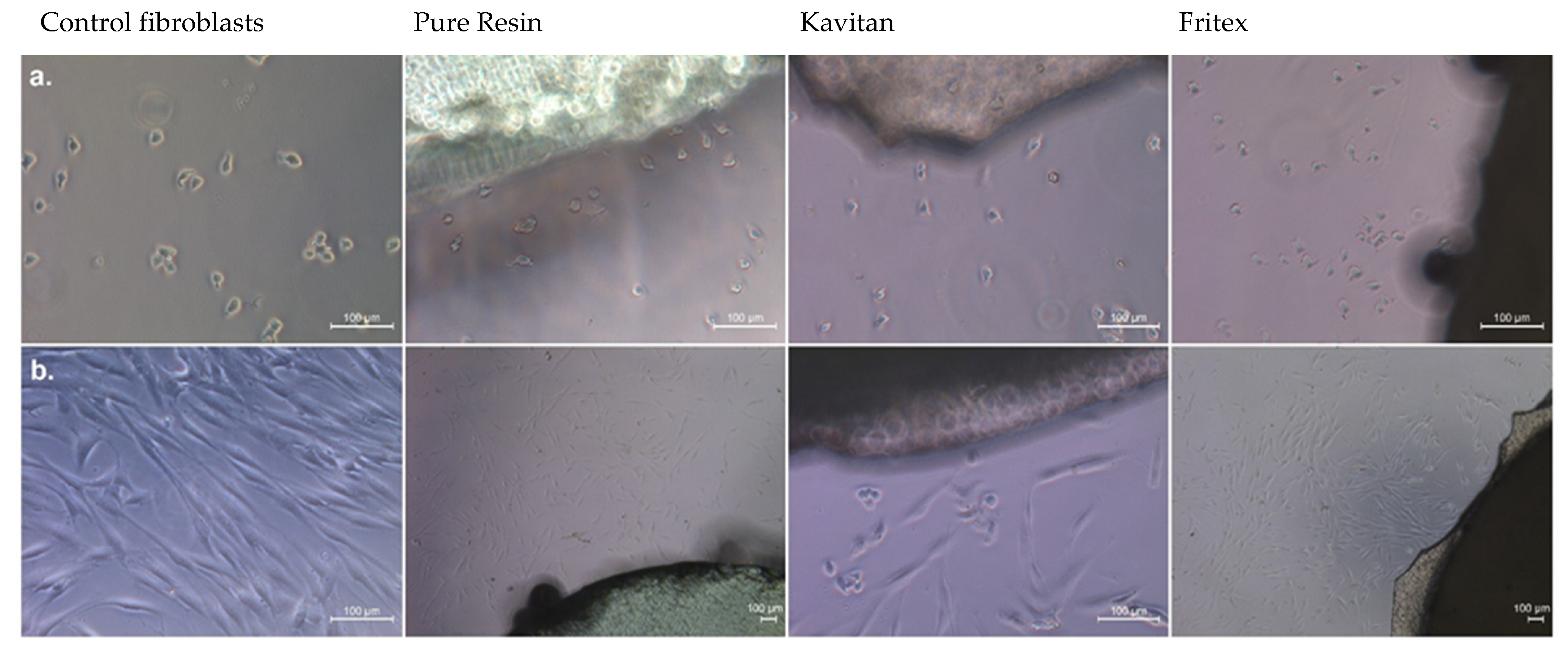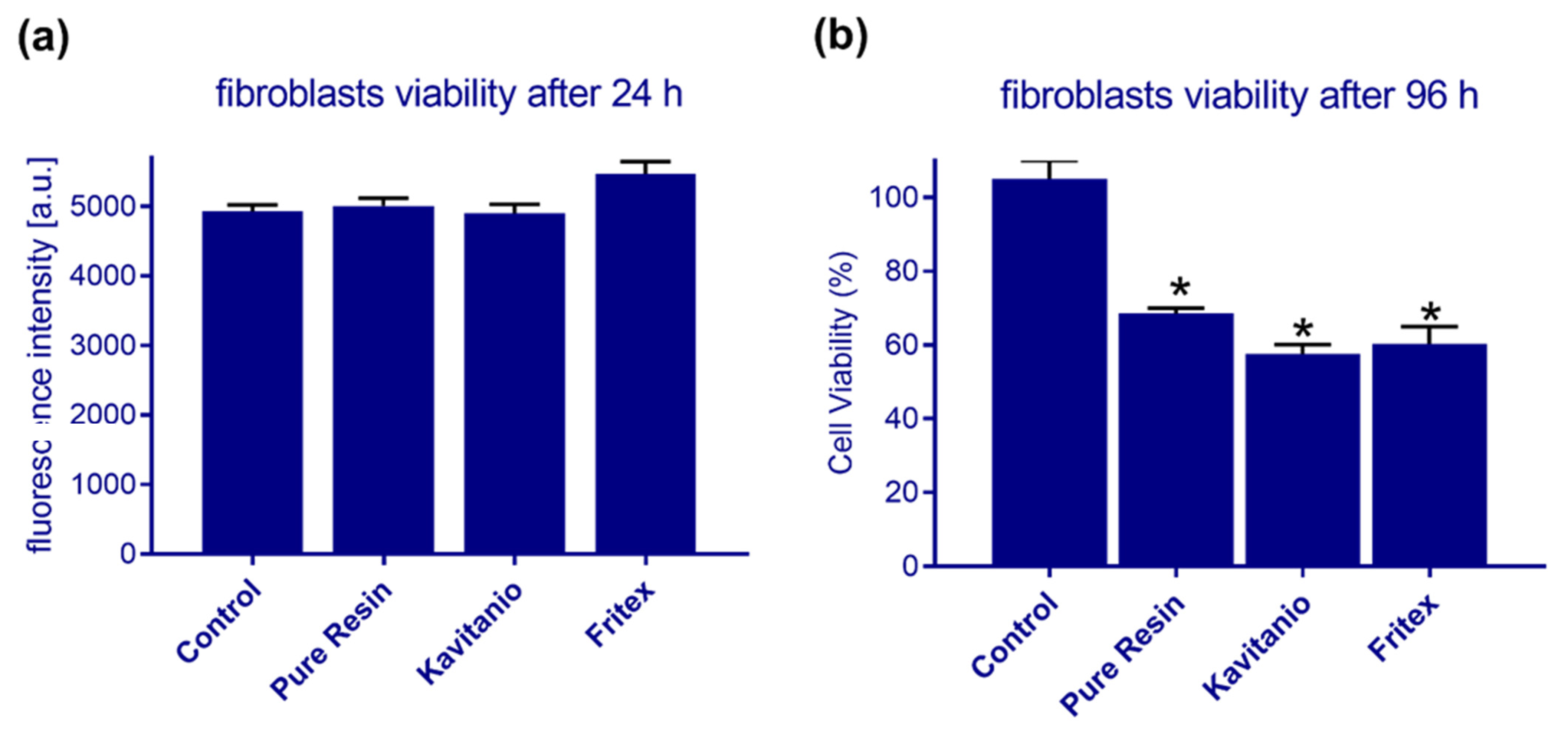Mechanical Properties, Cytotoxicity, and Fluoride Ion Release Capacity of Bioactive Glass-Modified Methacrylate Resin Used in Three-Dimensional Printing Technology
Abstract
:1. Introduction
2. Materials and Methods
2.1. Fracture Resistance
2.2. Sorption and Solubility
2.3. Leaching of Nonpolymerized Components
2.4. Determination of Fluoride Ion Release
2.5. Cell Culture
2.6. Evaluation of Cell Morphology and Migration
2.7. Cytotoxicity Assay Test—Direct Contact
2.8. Statistical Analysis
3. Results
4. Discussion
5. Conclusions
Author Contributions
Funding
Institutional Review Board Statement
Informed Consent Statement
Acknowledgments
Conflicts of Interest
Ethical Statement
References
- Fousová, M.; Vojtěch, D.; Kubásek, J.; Machová, M.; Dvorský, D. 3D Printing as an Alternative to Casting, Forging and Machining Technologies? Manuf. Technol. 2015, 15, 809–814. [Google Scholar] [CrossRef]
- Chin, S.Y.; Dikshit, V.; Priyadarshini, B.M.; Zhang, Y. Powder-Based 3D Printing for the Fabrication of Device with Micro and Mesoscale Features. Micromachines 2020, 11, 658. [Google Scholar] [CrossRef] [PubMed]
- Zaharia, C.; Gabor, A.-G.; Gavrilovici, A.; Negruțiu, M.-L.; Stan, A.T.; Idorași, L.; Sinescu, C. Digital Dentistry—3D Printing Applications. J. Interdiscip. Med. 2017, 2, 50–53. [Google Scholar] [CrossRef] [Green Version]
- Venkataganakarthik, E.; Ganapathy, D.; Visalakshi, R.M. Awareness of stereolithography among dental students. Drug Invent. Today 2019, 12, 1013–1017. [Google Scholar]
- Quan, H.; Zhang, T.; Xu, H.; Luo, S.; Nie, J.; Zhu, X. Photo-curing 3D printing technique and its challenges. Bioact. Mater. 2020, 5, 110–115. [Google Scholar] [CrossRef] [PubMed]
- Chung, Y.J.; Park, J.M.; Kim, T.H.; Ahn, J.S.; Cha, H.S.; Lee, J.H. 3D Printing of Resin Material for Denture Artificial Teeth: Chipping and Indirect Tensile Fracture Resistance. Materials 2018, 11, 1798. [Google Scholar] [CrossRef] [PubMed]
- Anadioti, E.; Musharbash, L.; Blatz, M.B.; Papavasiliou, G.; Kamposiora, P. 3D printed complete removable dental prostheses: A narrative review. BMC Oral Health 2020, 20, 343. [Google Scholar] [CrossRef]
- Revilla-León, M.; Matthew, M.J.; Zandinejad, A.; Özcan, M. A review on chemical composition, mechanical properties, and manufacturing work flow of additively manufactured current polymers for interim dental restorations. J. Esthet. Restor. Dent. 2018, 31, 1–7. [Google Scholar] [CrossRef] [Green Version]
- Suralik, K.M.; Sun, J.; Chen, C.Y.; Lee, S.J. Effect of Fabrication Method on Fracture Strength of Provisional Implant-Supported Fixed Dental Prostheses. Prosthesis 2020, 2, 325–332. [Google Scholar] [CrossRef]
- Piironen, K.; Haapala, M.; Talman, V.; Järvinen, P.; Sikanen, T. Cell adhesion and proliferation on common 3D printing materials used in stereolithography of microfluidic devices. Lab Chip 2020, 20, 2372. [Google Scholar] [CrossRef]
- Kumar, M. Cytotoxicity of 3d Printed Materials-An In-Vitro Study. Ph.D. Dissertation, The Tamilnadu Dr. M.G.R. Medical University, Tamil Nadu, India, 2019. [Google Scholar]
- Ahamed, S.F.; Kumar, M.; Vijayakumar, R.K.; Apros, A.S.; Kanna, A.S.; Indrapriyadharshini, K. Cytotoxic evaluation of directly 3D printed aligners and Invisalign. Eur. J. Mol. Clin. Med. 2020, 7, 1129–1141. [Google Scholar]
- Tiwari, S.; Kenchappa, M.; Bhayya, D.; Gupta, S.; Saxena, S.; Satyarth, S.; Singh, A.; Gupta, M. Antibacterial Activity and Fluoride Release of Glass-Ionomer Cement, Compomer and Zirconia Reinforced Glass-Ionomer Cement. J. Clin. Diagn. Res. 2016, 10, ZC90–ZC93. [Google Scholar] [CrossRef]
- De Caluwé, T.; Vercruysse, C.W.J.; Ladik, I.; Convents, R.; Declerc, H.; Marten, L.C.; Verbeeck, R.M.H. Addition of bioactive glass to glass ionomer cements: Effect on the physico-chemical properties and biocompatibility. Dent. Mater. 2017, 33, e180–e203. [Google Scholar] [CrossRef] [PubMed]
- Raszewski, Z.; Nowakowska, D.; Wieckiewicz, W.; Nowakowska-Toporowska, A. Release and Recharge of Fluoride Ions from Acrylic Resin Modified with Bioactive Glass. Polymers 2021, 13, 1054. [Google Scholar] [CrossRef] [PubMed]
- Tappa, K.; Jammalamadaka, U. Novel Biomaterials Used in Medical 3D Printing Techniques. J. Funct. Biomater. 2018, 9, 17. [Google Scholar] [CrossRef] [PubMed] [Green Version]
- Augustin, M.M.; Joke, D.; Bourleyi, S.I.; Shenda, L.P.; Fidele, N.B.; Gabriel, B.B.; Pierre, S.N.; Kazadi, E.K.; Ediz, E.I.; Pierrot, K.N.; et al. Risks Factors of Caries and Periodontal Diseases in the Patients, after 5 Years Use a Partial Removable Denture. Open J. Stomatol. 2016, 6, 185–192. [Google Scholar] [CrossRef] [Green Version]
- Raszewski, Z.; Nowakowska-Toporowska, A.; Weżgowiec, J.; Nowakowska, D.; Więckiewicz, W. Influence of silanized silica and silanized feldspar addition on the mechanical behavior of polymethyl methacrylate resin denture teeth. J. Prosthet. Dent. 2020, 123, 647.e1–647.e7. [Google Scholar] [CrossRef] [PubMed]
- International Organization for Standardization. EN ISO 4049. Dentistry—Polymer-Based Restorative Materials; ISO: London, UK, 2019. [Google Scholar]
- International Organization for Standardization. EN ISO 20795-1. Base Polymers—Part 1: Denture Base Polymers; ISO: London, UK, 2013. [Google Scholar]
- González, G.; Barualdi, D.; Martinengo, C.; Angelini, A.; Chiappone, A.; Roppolo, I.; Pirri, C.F.; Frascella, F. Materials Testing for the Development of Biocompatible Devices through Vat-Polymerization 3D Printing. Nanomaterials 2020, 10, 1788. [Google Scholar] [CrossRef]
- Ünal, E.I.; Kenar, A.; Aksu, M.L.; Taştekin, M. Spectrophotometric methods for the determination of fluoride ion using indole-3-acetic acid interaction with iron(III). Turk. J. Chem. 2019, 43, 415–423. [Google Scholar] [CrossRef]
- Saczko, J.; Dominiak, M.; Kulbacka, J.; Chwiłkowska, A.; Krawczykowska, H. A simple and established method of tissue culture of human gingival fibroblasts for gingival augmentation. Folia Histochem. Cytobiol. 2008, 46, 117–119. [Google Scholar] [CrossRef] [Green Version]
- Margolis, H.C.; Moreno, E.C.; Murphy, B.J. Effect of low levels of fluoride in solution on enamel demineralization in vitro. J. Dent. Res. 1986, 65, 23–29. [Google Scholar] [CrossRef] [PubMed]
- Arbabzadeh-Zavareh, F.; Gibbs, T.; Meyers, I.A.; Bouzari, M.; Mortazavi, S.; Walsh, L.J. Recharge pattern of contemporary glass ionomer restoratives. Dent. Res. J. (Isfahan) 2012, 9, 139–145. [Google Scholar] [CrossRef] [PubMed]
- Checherita, L.; Beldiman, M.A.; Stamatin, O.; Foia, U.; Forna, N. Aspects on Structure of Materials Used for Different Types of Occlusal Splints. Rev. Chim. 2013, 64, 864–867. [Google Scholar]
- Parreira-Lovoa, J.F.; de Camargo, I.L.; Erberelia, R.; Moraisa, M.M.; Fortulana, C.A. Vat Photopolymerization Additive Manufacturing Resins: Analysis and Case Study. Mater. Res. 2020, 23, e20200010. [Google Scholar] [CrossRef]
- Kamalak, H.; Kamalak, A.; Taghizadehghalehjoughi, A.; Hacımüftüoğlu, A.; Nalcı, K.A. Cytotoxic and biological effects of bulk fill composites on rat cortical neuron cells. Odontology 2018, 106, 377–388. [Google Scholar] [CrossRef] [Green Version]
- Lee, M.J.; Kim, M.J.; Kwon, J.S. Lee, S.B.; Kim, K.M. Cytotoxicity of Light-Cured Dental Materials according to Different Sample Preparation Methods. Materials 2017, 10, 288. [Google Scholar] [CrossRef]
- Korsuwannawong, S.; Srichan, R.; Vajrabhaya, L.O. Cytotoxicity evaluation of self-etching dentine bonding agents in a cell culture perfusion condition. Eur. J. Dent. 2012, 6, 408–414. [Google Scholar] [CrossRef] [Green Version]
- Puškar, T.; Trifković, B.; Koprivica, D.Đ.; Kojić, V.; Jevremović, A.; Mirković, S. In vitro cytotoxicity assessment of 3d printed polymer based epoxy resin intended for use in dentistry. Vojn. Pregl. 2017, 3, 1–10. [Google Scholar] [CrossRef] [Green Version]
- Lin, C.H.; Lin, Y.M.; Lai, Y.L.; Lee, S.Y. Mechanical properties, accuracy, and cytotoxicity of UV-polymerized 3D printing resins composed of Bis EMA, UDMA, and TEGDMA. J. Prosthet. Dent. 2020, 123, 349–354. [Google Scholar] [CrossRef]
- Popal, M.; Volk, J.; Leyhausen, G.; Geurtsen, W. Cytotoxic and genotoxic potential of the type I photo initiators BAPO and TPO on human oral keratinocytes and V79 fibroblasts. Dent. Mater. 2018, 34, 1783–1796. [Google Scholar] [CrossRef]




| Kavitan | SiO2 (26 ± 3%) | Al2O3 (29 ± 3%) | F (10%) | P2O5 (8%) | Na2O (4%) | SrO (17%) |
| Fritex | SiO2 (44 ± 3%) | Al2O3 (30 ± 3%) | F (6%) | P2O5 (3%) | Na2O (6%) | CaO (5%) |
| Composition | Flexural Strength [MPa] after 1 day | Flexural Strength [MPa] after 30 Days |
|---|---|---|
| 3D Resin | 54.99 ± 2.72 Aa | 46.29 ± 3.69 Ab |
| 3D Resin + 10% Fritex glass | 50.54 ± 2.97 Ba | 43.69 ± 2.87 Bb |
| 3D Resin + 10% Kavitan glass | 49.68 ± 3.61 Ba | 43.92 ± 2.10 Bb |
| Composition | Solubility [µg/mm3] after 7 Days | Sorption [µg/mm3] after 7 Days |
|---|---|---|
| 3D Resin | 0.42 ± 0.09 A | 15.76 ± 4.21 A |
| 3D Resin + 10% Fritex glass | 1.03 ± 0.11 B | 19.01 ± 2.14 B |
| 3D Resin + 10% Kavitan glass | 1.12 ± 0.13 B | 21.23 ± 3.57 B |
| Unmodified 3D Resin | 3D Resin + 10% Fritex | 3D Resin + 10% Kavitan |
|---|---|---|
| Wave length [nm] Absorption [A] 243 0.061 ± 0.012 282 0.146 ± 0.014 372 0.102 ± 0.016 | Wave length [nm] Absorption [A] 243 0.046 ± 0.017 282 0.104 ± 0.013 382 0.129 ± 0.011 | Wave length [nm] Absorption [A] 243 0.074 ± 0.013 282 0.164 ± 0.016 382 0.168 ± 0.013 |
Publisher’s Note: MDPI stays neutral with regard to jurisdictional claims in published maps and institutional affiliations. |
© 2022 by the authors. Licensee MDPI, Basel, Switzerland. This article is an open access article distributed under the terms and conditions of the Creative Commons Attribution (CC BY) license (https://creativecommons.org/licenses/by/4.0/).
Share and Cite
Raszewski, Z.; Kulbacka, J.; Nowakowska-Toporowska, A. Mechanical Properties, Cytotoxicity, and Fluoride Ion Release Capacity of Bioactive Glass-Modified Methacrylate Resin Used in Three-Dimensional Printing Technology. Materials 2022, 15, 1133. https://doi.org/10.3390/ma15031133
Raszewski Z, Kulbacka J, Nowakowska-Toporowska A. Mechanical Properties, Cytotoxicity, and Fluoride Ion Release Capacity of Bioactive Glass-Modified Methacrylate Resin Used in Three-Dimensional Printing Technology. Materials. 2022; 15(3):1133. https://doi.org/10.3390/ma15031133
Chicago/Turabian StyleRaszewski, Zbigniew, Julita Kulbacka, and Agnieszka Nowakowska-Toporowska. 2022. "Mechanical Properties, Cytotoxicity, and Fluoride Ion Release Capacity of Bioactive Glass-Modified Methacrylate Resin Used in Three-Dimensional Printing Technology" Materials 15, no. 3: 1133. https://doi.org/10.3390/ma15031133
APA StyleRaszewski, Z., Kulbacka, J., & Nowakowska-Toporowska, A. (2022). Mechanical Properties, Cytotoxicity, and Fluoride Ion Release Capacity of Bioactive Glass-Modified Methacrylate Resin Used in Three-Dimensional Printing Technology. Materials, 15(3), 1133. https://doi.org/10.3390/ma15031133








